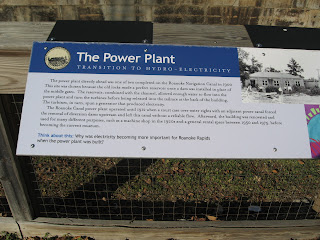"Boondocking", does not always mean you are out in the boonies. The rv term generally means you are camping without hookups, etc., electric, water, and sewer.
You may recall I added 4 six volt golf cart batteries, an inverter, battery monitor, battery charger, and generator to our standard rv equipment so we could "boondock" when we want to.
The last two nights we have stayed on two different Wal-Mart parking lots. Don't laugh, when it gets dark and you close the shades you really don't know you are in a parking lot, except for the traffic and night lights.
We pay nothing in parking fees but it is not totally free. Our little upright freezer runs off the inverter when we are traveling (or any time we are not hooked to 115 volts power). The inverter pulls power from the 4 six volt golf cart batteries.
When we stop with no hookups, we can watch satellite tv with the inverter also. Depleting the batteries means they have to be recharged. We can get by about one day and one night before the batteries need charging.
If we stayed in a campground with electricity every other night we would be just fine. When staying two nights without electricity we just run the generator.
Our inverter is not large enough to run our coffee pot, so I crank the generator in the morning to make coffee and at the same time it powers the battery charger to recharge the amps we have pulled out of our batteries.
Sounds simple enough but we are power hogs with our 32inch LCD tv, satellite, freezer and lights in the camper. Then we are using everything at night we are pulling about 25 amps out of the batteries.
I have 450 amps in the batteries but only have 225 usable amps because one should not regularly use more than 50% of the battery capacity if one wants the batteries to last. I prefer to use even less when possible.
After running the freezer all day the batteries have about 85% remaining and if we watch tv for three hours, the batteries are about 71% by next morning (remember the freezer is running 24 hours a day).
I found it best to run the generator at least an hour of our tv watching (remember with the generator running everything is on 115 volt power and the batteries are also being charged as opposed to being discharged). Running the generator for one hour while watching tv will have the batteries at the same state of charge (charging batteries as opposed to discharging the batteries) as watching tv and then running the generator for two hours.
Again if only off grid for one night before hooking to electricity, no use of the generator is needed as the battery charger is working when we are hooked to electricity.
When we swing back thu Arkansas in May, I plan to add solar panels to cut the use of the generator to a bare minimal.
There is no "free lunch" because our rv refriguator uses propane when we are not hooked to electricity or running the generator.
We used Wal-Mart parking to lower our over all monthly camping expenses, to test our equipment, and to save time.
Campgrounds are seldom close to the road and just driving 10 miles out of the way to camp overnight adds 2 hours when you consider the driving time and hooking and unhooking. Add in the added fuel costs and camping fees and it can amount to $20 to $50 dollars plus 2 lost hours. All for just a few hours sleep.
We can boondock about 4 days using our normal amount of water ( we carry 41 gallons of fresh water) and about a week if we really conserve. Should we need the air-conditioning, then we whould have to run the generator. At that point we might as well stay in a campground if one is nearby, if not, at least we still have the option of supplying our own electricity via our generator.
We are leaving Wilson, North Carolina heading north and plan to stay at Medoc Mountain State Park for 2 days. Most state parks are out in the boonies so we may not have internet via our our card or cell phone service. Out in the woods away from most everyone ( at least this time of year) and DARK at night. Hey, someone has to do it.
























